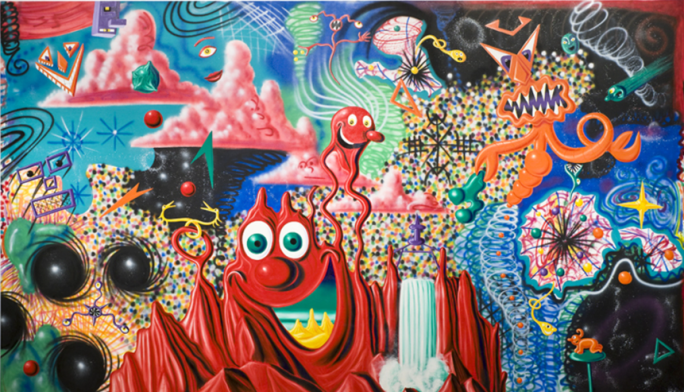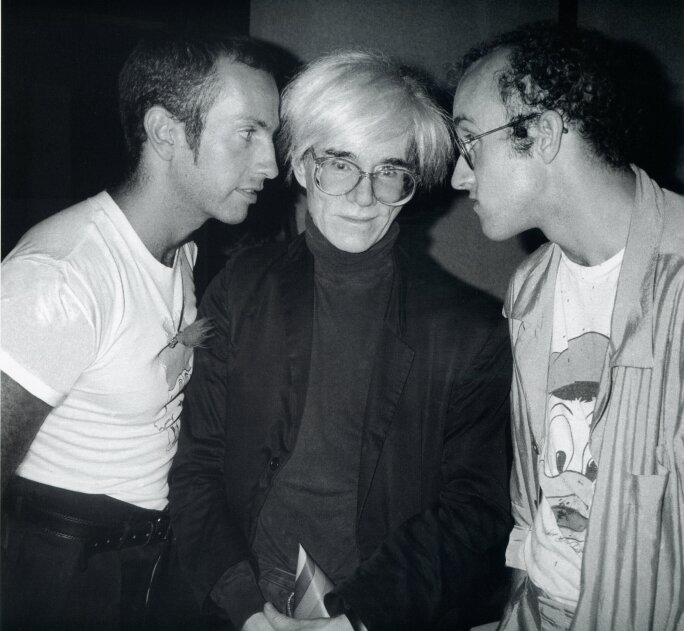"I believe that you don’t have to exclude the common public who maybe doesn’t have a knowledge about art history. I want to appeal to everyone, but on different levels."
A candy red face with eyes bleeding blue looks out and gives the audience a knowing and whimsical smirk; Kenny Scharf’s 2019 painting, Blip, is an icon of the artist’s recent revival of the Tondo series and shines as evidence of the artist’s supreme mastery of spray paint as a medium. The magic of Blip lies in its accessibility, allowing viewers to take from it what they want. On its surface, the painting is light, silly, and humorous, with an immensely bulbous nose and bright, catchy colors that make for an interesting and entertaining immediate viewing experience. For those willing and wanting to look further, Scharf’s work begins to open up, becoming a surreal, almost psychedelic, expression of human emotion and experience.
Scharf once described his 1984 painting, When the Worlds Collide, as an organized chaos that “allows the spirits to come out, like an explosion.” In the same interview, he stated, “I don’t want to be stifled by my own self because I want to reach outside myself” (Quoted in Osman Can Yerebakan, “Artist Kenny Scharf” The Guardian article, 2024, online). In making Blip and the other works in his 2018-20 revival of his famous Tondo paintings, Scharf has not only reached outside of himself, but he has transcended the boundaries of the square canvas and environments of his earlier paintings; to use borrow his words, he has freed the spirits his paintings had once contained. These spirits, part extensions of Scharf’s own emotional experience, part personifications of those he has encountered, create a compelling duality in Blip; the painting is universal in its refreshing style and recognizable expression, but deeply personal in its expression of Scharf’s emotional state at the time of its execution.

First and foremost, as a street artist, universality has and continues to be at the heart of Scharf’s art-making project. In the early 1980s, along with his roommate Keith Haring, and his good friend Jean-Michel Basquiat, Scharf brought his practice from the street into the studio and gallery; in making this transition he relinquished the site specificity inherent to graffiti, but retained the the medium of spraypaint and visual language that makes street art approachable. As he rose through the interdisciplinary and bohemian East Village scene of the 1980s, Scharf worked closely with his mentor and hero, Andy Warhol, adopting the pop iconography of Warhol’s practice and integrating it into his psychedelic scenes to create his now-iconic superpop maximalism.

Scharf is one of the last surviving street and pop artists of the 1980s East Village and continues to be a torchbearer for the ideologies of the moment, as Scharf says, “every project I undertake is building on my past experiences. My original approach is unchanged; it is a personal challenge to produce the best work possible every time. One very important and guiding principle to my work is to reach out beyond the elitist boundaries of fine art and connect to popular culture through my art,” (Kenny Scharf, Artist Website, Online). Blip’s balance between its whimsical surface and emotional depth exemplifies Scharf’s lifelong commitment to creating work that can be appreciated by everybody in any context, whether it be hanging on the white walls of a gallery or adorning a mural spray-painted on the side of a building.
"I'm carrying the torch for friends who couldn't keep it going"